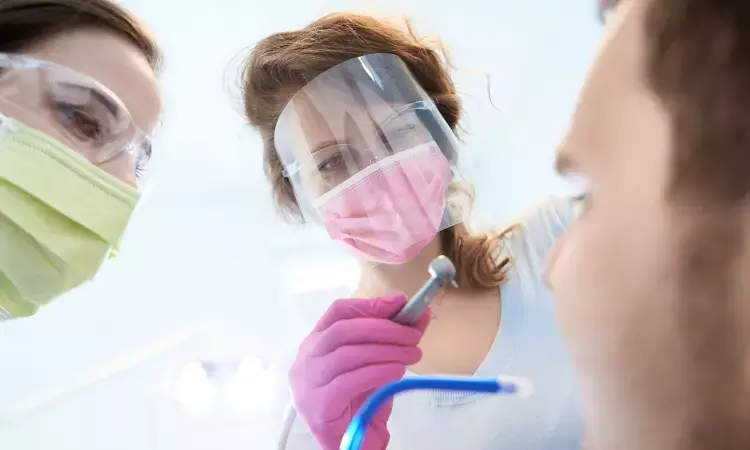- Home
- Medical news & Guidelines
- Anesthesiology
- Cardiology and CTVS
- Critical Care
- Dentistry
- Dermatology
- Diabetes and Endocrinology
- ENT
- Gastroenterology
- Medicine
- Nephrology
- Neurology
- Obstretics-Gynaecology
- Oncology
- Ophthalmology
- Orthopaedics
- Pediatrics-Neonatology
- Psychiatry
- Pulmonology
- Radiology
- Surgery
- Urology
- Laboratory Medicine
- Diet
- Nursing
- Paramedical
- Physiotherapy
- Health news
- Fact Check
- Bone Health Fact Check
- Brain Health Fact Check
- Cancer Related Fact Check
- Child Care Fact Check
- Dental and oral health fact check
- Diabetes and metabolic health fact check
- Diet and Nutrition Fact Check
- Eye and ENT Care Fact Check
- Fitness fact check
- Gut health fact check
- Heart health fact check
- Kidney health fact check
- Medical education fact check
- Men's health fact check
- Respiratory fact check
- Skin and hair care fact check
- Vaccine and Immunization fact check
- Women's health fact check
- AYUSH
- State News
- Andaman and Nicobar Islands
- Andhra Pradesh
- Arunachal Pradesh
- Assam
- Bihar
- Chandigarh
- Chattisgarh
- Dadra and Nagar Haveli
- Daman and Diu
- Delhi
- Goa
- Gujarat
- Haryana
- Himachal Pradesh
- Jammu & Kashmir
- Jharkhand
- Karnataka
- Kerala
- Ladakh
- Lakshadweep
- Madhya Pradesh
- Maharashtra
- Manipur
- Meghalaya
- Mizoram
- Nagaland
- Odisha
- Puducherry
- Punjab
- Rajasthan
- Sikkim
- Tamil Nadu
- Telangana
- Tripura
- Uttar Pradesh
- Uttrakhand
- West Bengal
- Medical Education
- Industry
The bio-aerosol reducing procedures used in dentistry not that effective: Study

The bio-aerosol reducing procedures like rubber dam application, pre-procedural oral rinse, and high-volume evacuators (HVE) used in dentistry are not that efficient, suggests a study published in the Acta Odontologica Scandinavica.
Bio-aerosols, are routinely generated and airborne in clinical dentistry due to the operative instrumentation within an oral environment bathed in salivary organisms. The sources of bio-aerosols in dental clinics were: ultrasonic scalers, high-speed handpieces, air turbines, three in one syringes, and air-water syringes. Studies conducted in hospitals reported 30 different bio-aerosol generating sources. Humans produced aerosols by coughing and sneezing.
SARS-CoV-2 transmission is responsible for the current pandemic that appears through airborne aerosols and droplets, thus, there has been an intense focus on such aerosol-generating procedures, and their reduction.
Samaranayake L et. al conducted a study aimed to evaluate the available data on three major measures: rubber dam application, pre-procedural oral rinse, and high-volume evacuators (HVE) aimed at reducing bio-aerosols.
The researchers searched PubMed via Ovid MEDLINE, EBSCO host, Cochrane Library and Web of Science databases between 01 January 1985 and 30 April 2020.
The results of the study are as follows:
· A total of 156 records in English literature were identified, and 17 clinical studies with 724 patients were included in the final analysis.
· Eligible articles revealed the inadequacy of three principal approaches used in contemporary dental practice to minimize such bio-aerosols, rubber dam application, pre-procedural oral rinses, and HVE.
· The latter is an extremely effective method to reduce bio-aerosols in dentistry, although no single method can provide blanket cover.
Thus, the researchers concluded that the present systematic review indicates that employing combination strategies of rubber dam, with a pre-procedural antimicrobial oral rinse, and HVE may contain bio-aerosols during operative procedures
Reference:
The efficacy of bio-aerosol reducing procedures used in dentistry: a systematic review by Samaranayake L et. al published in the Acta Odontologica Scandinavica.
https://doi.org/10.1080/00016357.2020.1839673
Dr. Shravani Dali has completed her BDS from Pravara institute of medical sciences, loni. Following which she extensively worked in the healthcare sector for 2+ years. She has been actively involved in writing blogs in field of health and wellness. Currently she is pursuing her Masters of public health-health administration from Tata institute of social sciences. She can be contacted at editorial@medicaldialogues.in.
Dr Kamal Kant Kohli-MBBS, DTCD- a chest specialist with more than 30 years of practice and a flair for writing clinical articles, Dr Kamal Kant Kohli joined Medical Dialogues as a Chief Editor of Medical News. Besides writing articles, as an editor, he proofreads and verifies all the medical content published on Medical Dialogues including those coming from journals, studies,medical conferences,guidelines etc. Email: drkohli@medicaldialogues.in. Contact no. 011-43720751


